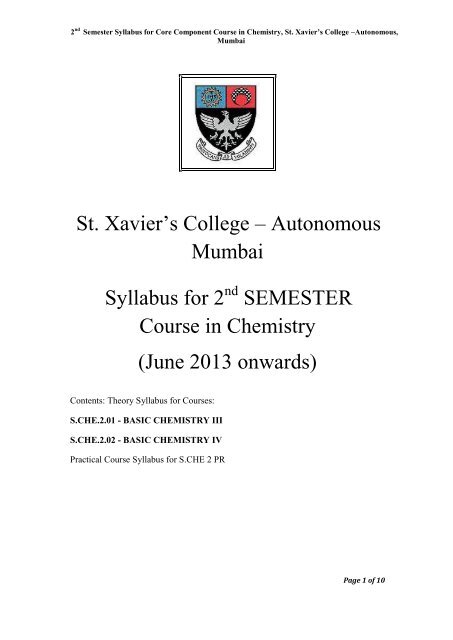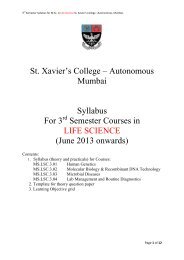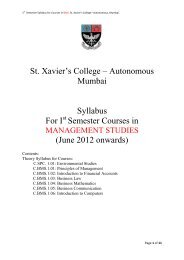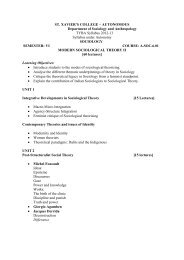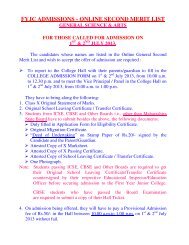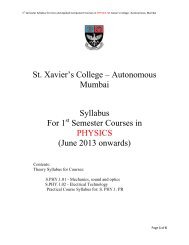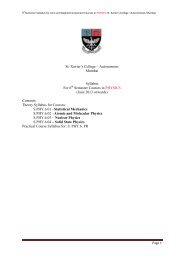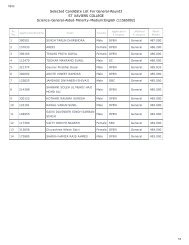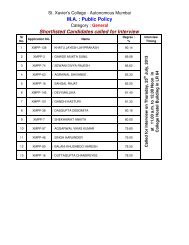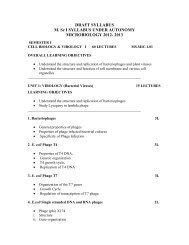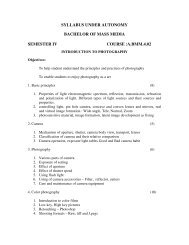SYLLABUS UNDER AUTONOMY CHEMISTRY Semester II
SYLLABUS UNDER AUTONOMY CHEMISTRY Semester II
SYLLABUS UNDER AUTONOMY CHEMISTRY Semester II
You also want an ePaper? Increase the reach of your titles
YUMPU automatically turns print PDFs into web optimized ePapers that Google loves.
2 nd <strong>Semester</strong> Syllabus for Core Component Course in Chemistry, St. Xavier’s College –Autonomous,<br />
Mumbai<br />
St. Xavier’s College – Autonomous<br />
Mumbai<br />
Syllabus for 2 nd SEMESTER<br />
Course in Chemistry<br />
(June 2013 onwards)<br />
Contents: Theory Syllabus for Courses:<br />
S.CHE.2.01 - BASIC <strong>CHEMISTRY</strong> <strong>II</strong>I<br />
S.CHE.2.02 - BASIC <strong>CHEMISTRY</strong> IV<br />
Practical Course Syllabus for S.CHE 2 PR<br />
Page 1 of 10
2 nd <strong>Semester</strong> Syllabus for Core Component Course in Chemistry, St. Xavier’s College –Autonomous,<br />
Mumbai<br />
SEMESTER <strong>II</strong><br />
BASIC <strong>CHEMISTRY</strong> <strong>II</strong>I<br />
<strong>SYLLABUS</strong> <strong>UNDER</strong> <strong>AUTONOMY</strong><br />
<strong>CHEMISTRY</strong><br />
COURSE: S.CHE.2.01<br />
[45 LECTURES]<br />
LEARNING OBJECTIVES:<br />
1. To familiarize the student with different types of chemical reactions<br />
2. To understand photochemistry with respect to certain laws<br />
3. To study and understand the tenets of thermodynamics pertaining to the first<br />
and second law of thermodynamics<br />
4. To understand and be able to elucidate the difference between molecular and<br />
atomic spectra, and understand various types of spectroscopy<br />
5. To understand the periodic trends in periodic properties of group 13 elements<br />
6. To apply theoretical concepts in order to solve numerical problems<br />
UNIT I<br />
(15 Lectures)<br />
1.1: Chemical Kinetics (10 L)<br />
1.1.1: Rate of Reaction: Definition of rate constant, measurement of reaction rates,<br />
order and molecularity, integrated rate equations for zero, first and second order<br />
reactions (second order reactions with equal and unequal initial concentration to be<br />
considered), kinetic characteristics of first and second order reactions, pseudo first<br />
order reactions.<br />
1.1.2 : Methods of determining order of reaction: by a) integration method b)<br />
graphical method c) equi-fraction method d) Ostwald’s isolation method.<br />
1.1.3 : Effect of temperature on rate of reaction, temperature coefficient,<br />
Arrhenius equation.<br />
1.2 : Photochemistry (5 L)<br />
1.2.1 : Laws of Photochemistry, photon yield (quantum yield) and its determination,<br />
primary and Secondary reactions, reasons for high and low quantum yields.<br />
1.2.2: Study of photochemical reactions: i ) reaction between hydrogen and chlorine,<br />
ii) dissociation of hydrogen iodide<br />
1.2.2 : Photosensitizes and photosensitized reactions, photochemical smog, ozone<br />
depletion, green house effect, concept of flash photolysis.<br />
Page 2 of 10
2 nd <strong>Semester</strong> Syllabus for Core Component Course in Chemistry, St. Xavier’s College –Autonomous,<br />
Mumbai<br />
UNIT <strong>II</strong><br />
(15 Lectures)<br />
2.1Thermodynamics (12 L)<br />
2.1.1.First Law of thermodynamics, internal energy, enthalpy, isothermal and<br />
adiabatic processes, P-V-T relation for adiabatic process.<br />
2.1.2. Second Law of thermodynamics, need for the law, Carnot cycle, mechanical<br />
efficiency,<br />
2.1.3. Concept of entropy, physical significance of entropy, entropy changes<br />
accompanying change of state and transition,<br />
2.1.4. Helmholtz’s and Gibbs Free energy, relation between them, criteria of<br />
spontaneity<br />
2.2 Introduction to Molecular Spectroscopy (3 L)<br />
2.2.1 Nature of electromagnetic radiation, interaction of EMR with matter:<br />
absorption, Emission, fluorescence and scattering<br />
2.2.2 Energy types and energy levels for atoms and molecules<br />
2.2.3 Types of spectroscopy: quantization of energy, regions of electromagnetic<br />
spectrum, and Different types of spectroscopy<br />
2.2.4 General applications of different spectroscopic techniques (qualitative<br />
discussion: only Introduction)<br />
UNIT <strong>II</strong>I<br />
(15 Lectures)<br />
3.1 Transition Elements (7 L)<br />
3.1.1 Definition<br />
3.1.2. 3d, 4d and 5d series of transition elements, their electronic configuration and<br />
general Characteristics<br />
3.1.3. Chemistry of 3d series of transition elements with reference to:<br />
a) Variable oxidation states<br />
b) Colour<br />
c) Magnetic property<br />
d) Catalytic property<br />
e) Complex formation<br />
Page 3 of 10
2 nd <strong>Semester</strong> Syllabus for Core Component Course in Chemistry, St. Xavier’s College –Autonomous,<br />
Mumbai<br />
3.2 Comparative Chemistry of group 13 elements (8 L)<br />
3.2.1 Trends in metallic character, oxidation states, melting and boiling points, inert<br />
pair effect<br />
3.2.2. Structures of electron deficient compounds with respect to boron hydrides.<br />
3.2.3 Chemistry of aluminum compounds: halides, oxides and alkyls.<br />
CIA: MCQ quiz<br />
REFERENCE BOOKS:<br />
1. Textbook of Physical Chemistry, Samuel Glasstone<br />
2. Physical Chemistry, Ira Levine, 5 th Edition, 2002 Tata McGraw Hill Publishing<br />
Co. Ltd.[ Chapter 4 , 14]<br />
3. Physical Chemistry, G.M. Barrow, 6 th Edition, Tata McGraw Hill Publishing Co.<br />
Ltd. New Delhi.<br />
4. The Elements of Physical Chemistry, P.W. Atkins, 2 nd Edition, Oxford<br />
University Press, Oxford.<br />
5. University Chemistry, Bruce Mahan<br />
6. Textbook of Physical Chemistry, Sharma and Puri<br />
7. F.A.Cotton,G.Wilkinson and P.L.Gauss, Basic Inorganic Chemistry, 3 rd<br />
Edition, J.Wiley and Sons, Inc.(1995)<br />
8. J.D.Lee,Concise Inorganic Chemistry,5 th Edition, Oxford University press,<br />
9. Environmental Chemistry, A.K. De, Wiley Eastern Ltd., New Delhi, 1989<br />
10. Fundamental concepts of Environmental Chemistry, G.S.Sodhi<br />
11. Advanced Inorganic Chemistry, Bahl, Anand, and Tuli, Vol. 1 and 2<br />
*********************************************************************<br />
Page 4 of 10
2 nd <strong>Semester</strong> Syllabus for Core Component Course in Chemistry, St. Xavier’s College –Autonomous,<br />
Mumbai<br />
BASIC <strong>CHEMISTRY</strong> IV<br />
Course No: S.CHE.2.02<br />
LEARNING OBJECTIVES:<br />
1. To understand the concept of isomerism, and represent the structure of<br />
organic compounds<br />
2. To understand mechanisms of certain reactions and predict the outcome of an<br />
organic reaction given the identities of reactants.<br />
3. To study preparation and properties of unsaturated hydrocarbons<br />
4. To understand concept of aromaticity, non-aromaticity and anti aromaticity as<br />
applied to benzenoid and non-benzenoid carbocycles<br />
5. To study the reactivity of various aliphatic organic compounds and their<br />
interconversions in 5 – 6 steps<br />
6. To understand the role and significance of metal ions like Na, K, Fe and Cu in<br />
biological systems<br />
7. To introduce the basic concepts of environmental chemistry and create<br />
awareness about pollution and conservation of the environment<br />
8. To understand the trends in periodic properties of group 14 elements<br />
9. To study the chemistry of Silicon<br />
10. To apply theoretical concepts in order to solve numerical problems<br />
UNIT I<br />
(15 Lectures)<br />
1.1 Stereochemistry of organic compounds (8 L)<br />
1.1.1 Isomerism : Types of isomerism ; Structural isomerism (chain , position and<br />
functional) and stereoisomerism.<br />
1.1.2 Chirality : Configuration, chirality and enantiomers, stereogenic / chiral centre,<br />
asymmetric carbon atom, representation of configuration by flying wedge formula<br />
and projection formulae - Fisher, Newman and Sawhorse.<br />
1.1.3 Stereochemistry of carbon compounds with one and two similar and dissimilar<br />
asymmetric carbon atoms, enantiomers, diastereomers and racemic mixtures and<br />
their properties; threo, erythro and meso isomers.<br />
1.1.4 Diastereomerism : (Geometrical isomerism) due to restricted rotation around<br />
carbon – carbon double bond.<br />
1.1.5 Conformations : Conformations of ethane, difference between conformation<br />
and configuration.<br />
1.2 Alkenes , Cyclo-alkenes Alkynes (7 L )<br />
1.2.1 Introduction : Concept of elements of unsaturation, applications of alkenes,<br />
cycloalkenes and alkynes.<br />
1.2.2 Preparation of alkenes & cycloalkenes (up to 6 carbons) : Dehydration of<br />
alcohols, dehydrohalogenation of haloalkanes. E1 and E2 mechanisms, Saytseff’s<br />
rule and Hoffman rule<br />
1.2.3 Reactions of Alkenes: Cycloalkenes (up to 6 carbons); Hydrogenation,<br />
epoxidation, permanganate oxidation, ozonolysis, halogenation, addition of HX –<br />
Page 5 of 10
2 nd <strong>Semester</strong> Syllabus for Core Component Course in Chemistry, St. Xavier’s College –Autonomous,<br />
Mumbai<br />
Markovnikov and anti- Markovnikov addition with mechanism, hydroboration –<br />
oxidation , Diels – Alder reaction.<br />
1.2.4 Preparation of alkynes : dehydrohalogenation of vicinal dihalides and<br />
haloalkenes; from metal carbides.<br />
1.2.5 Reactions of alkynes : Hydration, addition of HX , selective hydrogenation to<br />
cis and trans alkenes, acidity of terminal alkynes, preparation of metal acetylides<br />
and their alkylation.<br />
UNIT <strong>II</strong><br />
(15 Lectures)<br />
2.1 Aromaticity and aromatic hydrocarbons (4 L)<br />
2.1.1 Aromaticity : characteristic properties of aromatic compounds, Huckel’s rule,<br />
Aromaticity and anti-Aromaticity, resonance energy<br />
2.1.2 Aromatic hydrocarbons : a) benzenoid hydrocarbons: benzene, naphthalene,<br />
anthracene , phenanthrene , b) non- benzenoid ions : cyclopropenium ,<br />
cyclopentadienide, cycloheptatrienium ions<br />
2.1.3 Anti- aromatic hydrocarbons : cyclobutadiene, structure of cyclooctatetraene.<br />
2.2 Reactions of aliphatic organic compounds and their inter-conversions (11 L)<br />
2.2.1.Reactions of alkyl halides with : aqueous alkali; alcoholic alkali<br />
(dehydrohalogenation); potassium cyanide, conversion of alkyl cyanide further<br />
to primary amine and carboxylic acid; ammonia; silver salt of carboxylic acid;<br />
sodium alkoxide; formation of Grignard reagent; Wurtz reaction.<br />
2.2.2. Reaction of alcohols with : sodium metal; HX; PCl 3 , PCl 5 , SOCl 2 ;<br />
dehydration; oxidation of primary , secondary and tertiary alcohols.<br />
2.2.3. Reactions of aldehydes and ketones :<br />
a) Addition to carbonyl compounds: i) HCN ii) Grignard reagent;<br />
b) Condensation reaction with hydroxylamine;<br />
c) Aldol condensation<br />
d) Reduction of aldehydes and ketones: i) catalytic reduction; ii) Clemmensen<br />
reduction iii) reduction with LiAlH 4 and NaBH 4 iv) Wolff - Kishner reduction<br />
e) Haloform reaction<br />
2.2.4. Reaction of acids esters and amines :<br />
a) Acids : Formation of salt, anhydride, amide, acid halide, ester and alkanes.<br />
b) Esters: Hydrolysis of esters with acids and alkalis; reaction of esters with<br />
Grignard’s reagent,<br />
c)Amides: Hydrolysis of amides, reduction of amides, Hoffman – bromamide<br />
reaction<br />
2.2.5. Reaction of amines:<br />
a) Formation of amines from nitro-alkanes, oximes,<br />
b) Acetylation of amines with acetic anhydride and acetyl chloride.<br />
c) Action of nitrous acid on primary / secondary / tertiary amines.<br />
d) Methylation of primary / secondary / tertiary amines yielding quarternary<br />
ammonium salts, Hoffman elimination.<br />
Page 6 of 10
2 nd <strong>Semester</strong> Syllabus for Core Component Course in Chemistry, St. Xavier’s College –Autonomous,<br />
Mumbai<br />
Note : Each reaction should be studied with respect to compounds with up to 6<br />
carbon atoms. Based on these and the reactions of alkanes, alkenes and alkynes,<br />
multi-step synthesis of compounds having one functional group are expected, the<br />
number of carbon atoms in each being not more than six. No mechanisms are<br />
expected.<br />
UNIT <strong>II</strong>I<br />
(15 lectures)<br />
3.1 Basic Bio-inorganic Chemistry: (2 L)<br />
3.1.1 Introduction, essential and non-essential elements in biological systems , role of<br />
metal ions such as Na, K, Fe and Cu in biological systems.<br />
3.2 Environmental Chemistry (6 L)<br />
3.2.1 Study of various gaseous pollutants, such as oxides of nitrogen, carbon and<br />
sulphur with respect to sources of emissions, fate, health hazards, and control<br />
measures.<br />
3.3. Comparative Chemistry of Group 14 elements: (7 L)<br />
3.3.1 Trends in metallic character, oxidation state, melting and boiling points, inert<br />
pair effect,<br />
3.3.2 Catenation and allotropy with special reference to carbon (to include study of<br />
fullerenes and carbon nano-tubes)<br />
3.3.3. Chemistry of Silicon with special reference to methods of purifications, zone<br />
refining and single crystal method,<br />
3.3.4 Introduction to silicones with reference to methods of preparation and their uses<br />
CIA: MCQ quiz<br />
REFERENCE BOOKS:<br />
1. Schaum Outline Series: College Chemistry<br />
2. Organic Chemistry, R.T. Morrison and R.N. Boyd, 6 th Edition, Pearson<br />
Education.<br />
3. Organic Chemistry, T.W.G. Solomon and C.B. Fryhle, 8 th Edition, John<br />
Wiley & Sons, 2004.<br />
4. A guide to mechanism in Organic Chemistry, 6 th Edition, Peter Sykes, Pearson<br />
Education.<br />
5. Fundamentals of Organic Chemistry, G. Marc Loudon, 4 th Edition, Oxford<br />
University Press, 2006.<br />
Page 7 of 10
2 nd SEMESTER Syllabus for Core Component Course in Chemistry, St. Xavier’s College –Autonomous, Mumbai<br />
6. Organic Chemistry, John McMurry<br />
7. Organic Chemistry, L.G. Wade Jr. and M.S. Singh, 6 th Edition, 2008.<br />
8. Organic Chemistry, Paula Y. Bruice, Pearson Edication, 2008.<br />
9. Organic Chemistry, J.G. Smith, 2 nd Edition, Special Indian Edition, Tata<br />
McGraw Hill.<br />
10. F.A.Cotton,G.Wilkinson and P.L.Gauss, Basic Inorganic Chemistry, 3 rd<br />
Edition, J.Wiley and Sons, Inc.(1995)<br />
11. J.D.Lee,Concise Inorganic Chemistry,5 th Edition, Oxford University press,<br />
12. Environmental Chemistry, A.K. De, Wiley Eastern Ltd., New Delhi, 1989<br />
13. Fundamental concepts of Environmental Chemistry, G.S.Sodhi<br />
14. Advanced Inorganic Chemistry, Bahl, Anand, and Tuli, Vol. 1 and 2<br />
**********************************************************************************<br />
Page 8 of 10
2 nd SEMESTER Syllabus for Core Component Course in Chemistry, St. Xavier’s College –Autonomous, Mumbai<br />
PRACTICAL <strong>CHEMISTRY</strong>:<br />
Course No. S.CHE.2.PR<br />
<strong>Semester</strong> 2: Course 1<br />
Physical Chemistry Experiments<br />
Qualitative Analysis<br />
<strong>Semester</strong> 2 Course 2<br />
Organic Spotting<br />
Course 1:<br />
(1) PHYSICAL <strong>CHEMISTRY</strong> EXPERMENTS:<br />
1. Study of acid catalyzed hydrolysis of methyl acetate – rate constant to be<br />
evaluated graphically and from calculations.<br />
2. To determine the relative strength of HCl and H 2 SO 4 by hydrolysis of methyl<br />
acetate method.<br />
3. To determine strength of commercial sample of HCl and acetic acid. (standard<br />
solution of succinic acid to be prepared, NaOH solution to be supplied)<br />
4. To determine viscosity of the given liquid using Ostwald’s Viscometer.<br />
5. To determine refractive index of the given liquid using Abbe’s refractometer.<br />
(2) Inorganic Semi-Micro Qualitative Analysis: of a sample containing four<br />
anions from those given below: Cl - , Br - , I - , CO 3 2- , S 2- , SO 3<br />
2- , SO4 2- , NO 2 - , NO 3 -<br />
CrO 4 2- , PO 4<br />
3- , BO3 3-<br />
Preliminary dry tests, preparation of solution and wet tests for confirmation of the<br />
presence of 4 anions (complexities of anions to be included).<br />
Minimum 6 mixtures should be analyzed.<br />
Course 2:<br />
(3) Organic Spotting:<br />
Characterization of organic compounds (by micro-scale techniques).<br />
An organic compound containing only one functional group is to be characterized<br />
and identified.<br />
Analysis to include the following tests: preliminary observations, solubility profile,<br />
elemental analysis, functional group identification, m.p. / b.p.<br />
Type of compounds: carboxylic acids, phenols, aldehydes and ketones, alcohols,<br />
esters, amines, amides, aromatic nitro compounds, hydrocarbons, halogenated<br />
hydrocarbons. (at least one compound from each type)<br />
Quantity of compounds to be given: about 1 gm / 2 ml.<br />
Minimum 12 compounds should be analyzed during the course.<br />
Page 9 of 10
2 nd SEMESTER Syllabus for Core Component Course in Chemistry, St. Xavier’s College –Autonomous, Mumbai<br />
CIA AND END SEMESTER PRACTICAL EXAMINATION<br />
CIA Test<br />
Course 2.01: Inorganic Semi-Micro Qualitative Analysis<br />
Course 2.02: Organic Spotting<br />
Journal: 5 marks per course.<br />
CIA: 15 marks per course<br />
Duration: 3 periods to be conducted during regular practicals by the Faculty- incharge.<br />
CIA for each course will be an exercise to test a practical skill (Qualitative /<br />
Quantitative)<br />
End <strong>Semester</strong> Examination:<br />
Course 2.01: Physical Chemistry Experiments<br />
Course 2.02: Organic Spotting<br />
30 marks per course. This includes a 5 mark written test based on the theory behind<br />
all the experiments conducted per course.<br />
Duration: 3½ hrs per course. Students are to perform two experiments (one per<br />
course).<br />
Page 10 of 10


